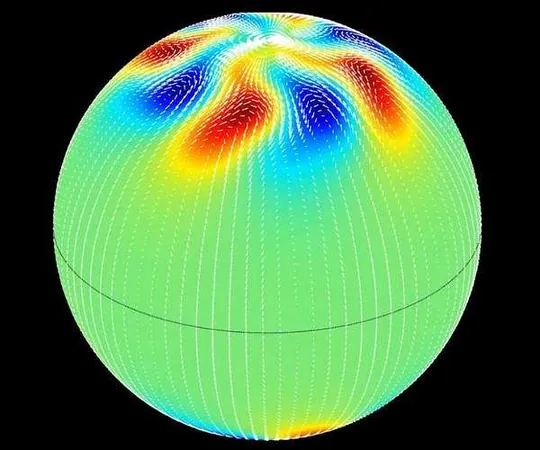
Solar Vortices: A Groundbreaking Discovery that Could Change Our Understanding of the Sun!
2024-11-12
Author: Li
Recent groundbreaking research spearheaded by the National Science Foundation's National Center for Atmospheric Research (NSF NCAR) has unveiled the possibility of swirling polar vortices existing on the Sun, similar to those observed on Earth and other celestial bodies. This astonishing revelation suggests that the Sun's magnetic fields play a crucial role in the formation and behavior of these vortices, potentially impacting solar cycles and space weather predictions.
The study, published in the prestigious Proceedings of the National Academy of Sciences (PNAS), explores the dynamics of solar magnetism and the characteristics of the Sun’s polar regions. "No one can say for certain what is happening at the solar poles," stated Mausumi Dikpati, a senior scientist at NSF NCAR and the lead researcher. "However, this new research provides an intriguing glimpse into what we might anticipate when we finally get to observe the solar poles in detail."
Understanding the Solar Vortex Phenomenon
On Earth, polar vortices are formed due to the Coriolis force acting on cold air masses, which are confined at the poles. When weak, these vortices can cause frigid Arctic air to extend toward mid-latitudes, affecting weather patterns significantly. NASA's missions to Jupiter with its Juno spacecraft and Saturn with Cassini have documented polar vortices, revealing complex atmospheric phenomena on those planets.
Staggeringly, scientists have also detected similar polar vortices on other planetary bodies, including Mars, Venus, Uranus, Neptune, and Titan, Saturn's largest moon. This raises the question: could our Sun, surrounded by a charged plasma field, also exhibit such vortex phenomena?
Innovative Modeling Techniques
Since direct observations of the Sun's poles are currently unattainable, the research team employed advanced computer simulations to shed light on this question. Their models suggest that solar vortices could form in a manner distinctly aligned with the Sun's magnetic cycle, resembling a ring of vortices near 55 degrees latitude—akin to Earth's Arctic Circle. This phenomenon occurs during a pivotal magnetic event labeled the "rush to the poles."
As a solar cycle approaches its peak, the magnetic field at the poles undergoes a flip in polarity, subsequently resulting in vortices that migrate toward the poles before dissipating. The configuration and number of these vortices fluctuate depending on the intensity of the solar cycle, offering further avenues for exploration.
The Future of Solar Research and Space Missions
The implications of this research are monumental for our understanding of the Sun and its impact on space weather. The simulations suggest that polar vortices should be observable for most of the solar cycle, barring the solar maximum phase. Scott McIntosh from Lynker, a co-author of the study, stressed the significance of timing in space missions aimed at observing these phenomena. "Launching a solar mission at the right time is crucial; we can't afford to miss these important observations!" he emphasized.
The upcoming Solar Orbiter mission, a collaborative effort by NASA and the European Space Agency, is poised to be the first to provide comprehensive observations, although its timing corresponds with the solar maximum. McIntosh urges the need for missions with diverse observation angles to advance our understanding further. "To make real progress in understanding, it’s essential that we gather the data necessary to validate our simulations," he added.
As we continue to unlock the mysteries of the Sun, the existence of polar vortices may not only redefine our astronomical knowledge but also enhance the prediction of space weather events that could impact satellite communications and power grids on Earth. Keep an eye on the skies—this is just the beginning of a solar revolution!




 Brasil (PT)
Brasil (PT)
 Canada (EN)
Canada (EN)
 Chile (ES)
Chile (ES)
 España (ES)
España (ES)
 France (FR)
France (FR)
 Hong Kong (EN)
Hong Kong (EN)
 Italia (IT)
Italia (IT)
 日本 (JA)
日本 (JA)
 Magyarország (HU)
Magyarország (HU)
 Norge (NO)
Norge (NO)
 Polska (PL)
Polska (PL)
 Schweiz (DE)
Schweiz (DE)
 Singapore (EN)
Singapore (EN)
 Sverige (SV)
Sverige (SV)
 Suomi (FI)
Suomi (FI)
 Türkiye (TR)
Türkiye (TR)